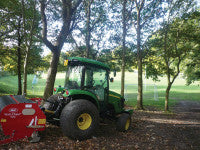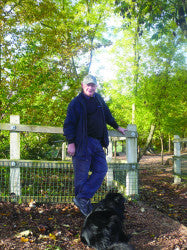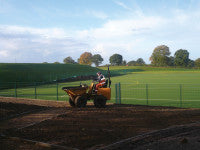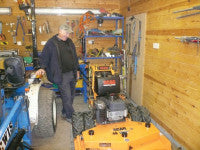Great Danes ... and Pepsi!
 "Security has assumed greater importance since Danes Hill took in its 'celebrity' pupils, and you're rarely, if ever, off camera, but you grow accustomed to it"
"Security has assumed greater importance since Danes Hill took in its 'celebrity' pupils, and you're rarely, if ever, off camera, but you grow accustomed to it"
The Coalition's decision to axe central funding for school sports partnerships threatens to undo much of the good work achieved over the last few years. Coupled with the scrapping of the multi-billion pound Building Schools for the Future (BSF) programme, education looks set to face a shaky few years in a new age of austerity.
For the private sector, it seems, the future looks far brighter. Tough economic times mean the need to keep a competitive edge by providing top-notch sports facilities, as well as a first class education.
Surrounded by prime Surrey countryside, and one of a welter of private educational establishments in the region, Danes Hill School in leafy Oxshott is investing heavily in its sporting future and is entering the final stages of a major extension to its natural and synthetic sport surfaces under a million pound-plus project.
Danes Hill School first opened its educational doors in 1947, teaching just sixteen pupils. The history of the school's development is patchily documented, yet the record of Danes Hill House, which forms the commanding centrepiece of the school, makes fascinating reading.
The construction of the house was first realised with the opening of the railway through Oxshott in 1884, laid through the village because Queen Victoria did not want 'the permanent way' to pass too near to the royal residence at Claremont. Her wish also explains why Esher railway station stands so far from the town centre, while Cobham station is sited more than a mile from the village.

The exact date of the Danes Hill mansion is unknown but, in 1892, Arthur Edgell Eastwood, proprietor of a cement company, listed Danes Hill as his residence in the Electoral Register. Then, in 1901, the house was bought by R J Lambert, a member of the Drury Lane tobacco family.
The estate stretched over 67 acres, and included a model farm, several cottages, arable land, pasture, an orchard and a kitchen garden. Over the following years, the house passed into the hands of several owners and the estate shrank, until in 1938, 47 acres were bought by the Crown Estate Commissioners.
During the Second World War, the house was acquired by Borax Consolidated Ltd. as a base for evacuated employees and, according to local records, Canadian troops were also based there in the build-up to the D-Day landings.
The postwar economic climate meant Danes Hill soon became untenable as a private residence and little is known about its transition into a school. However, by 1948, the school was being advertised as a boarding and day preparatory school with J Hendy-Morton and T J Powell-Shehan its principals.
In 1951, F R H Bevan joined Hendy-Morton as principal and in 1952 the first scholarships to public schools had been won, with the school roll expanded to 61 boys.

In 1969, Danes Hill was bought by the triumvirate of Graham Hill, Michael Bolan and J E Todd, and it was during this time that Danes Hill's expansion and educational changes really came on apace.
Boarding was abandoned in 1975 and, the following year, the school acquired the lease for Wren's Hill and The Ridgeway, on which much needed new playing fields were constructed.
The Davies Educational Trust (subsequently the Vernon Educational Trust) acquired Danes Hill in 1984 and more rapid expansion of the school's facilities followed throughout the decade.
The school celebrated its Golden Jubilee in 1997 and the adventure playground at the main school was presented by the Friends of Danes Hill to mark the event. A year after the Link Building was opened in 2002, the school added its first synthetic sports surface.
Currently, the school has over 850 pupils, including several offspring of high profile celebrities and sportspeople - due in part to Chelsea FC's training ground at Stoke D'Abernon being sited a stone's throw from the school perimeter.
Under new headmaster, Willie Murdock, there has been no let-up in the school's development programme, which has included the opening of a new reception and Year 1 classroom block, new art and design building on the main school site, named in honour of athlete and former headmaster, Robin Parfitt.
In November 2009, the Stable performing arts block was completed, adding new music practice rooms and a state-of-the-art theatre with dance facilities.

One of Danes Hill's most significant sporting moves to date is well underway, with the expansion of the footprint of the school by 55 acres of farmland and the development of its sports provision at the rear on twelve acres of this.
The million plus investment in a sand dressed synthetic pitch, six new football/rugby pitches and two cricket squares will add to the already generous sports turf provision at the school and are expected to be handed back to the school by the main contractor by late spring.
Danes Hill recognises the value of investing in quality provision and high-calibre staff - a commitment that reaches beyond the confines of the classroom. The turfcare team have reaped the benefits of the school's faith in sporting provision - witnessed by the purchase of a fleet of machinery and equipment under a healthy budget and a team of committed individuals who are helping to realise the school's ambitions.
Coordinating it all is Head Groundsman, Tony Steadman, who runs a team of four: assistants Scott Welland and Scott Duncan, gardener Mark Burke and newest recruit, the man known simply as 'Slav', and Tony's ever-present four-legged friend and school 'mascot', Pepsi the collie cross - a rescue dog from Battersea Dogs Home.
These five tend to all aspects of the vast site, from its variety of sports pitches catering for school teams that start with the under 5s, to the adventure playground, woodland areas, conservation sites and now, Dane Hill's latest phase of development.

Tony joined the school in 2001, after enjoying a varied career ranging from mechanic to local authority parks groundsman and latterly, the schools sector. He began work in car repair centres, a job he stayed in only briefly before moving into a part-time position in Epson and Ewell Borough Council's parks department. It was here he found his 'niche' and, to reward his commitment, the council offered him a permanent post.
His time at the council gave him the opportunity to train up to the standard needed to enter groundsmanship, gaining his City and Guilds Amenity and Horticulture qualifications at Merrist Wood College.
Now, armed with the necessary qualifications, Tony secured a job at the Shell-owned Lensbury sports grounds in Teddington, staying there for a decade, before moving to a a position with commodities dealer, Cargill, who owned Knowle Hill Park in Cobham, a tenure he kept for nine years.
In the mid-1990s, Tony entered the private education sector, joining the neighbouring Reed School as head groundsman. It's a period the 62 year-old recalls with fondness.
"It was a great time in my life - both the atmosphere and my colleagues made it a marvellous place to work," he says. "I ended up leaving for two reasons. Firstly, the job at Danes Hill came up, which offered good opportunities for my career, and secondly, I often came to loggerheads about our budget and our provisions, which makes what can be an already challenging job that bit more difficult."
Imagine his joy, therefore, when Tony found that his new employer shared the same beliefs in professional development that he did - a vision that has ensured that all the team have been trained up in everything, from handling pesticides and working at heights, to fire procedures and other know-how necessary to tackle the daily requirements of the job.
It is this commitment to investment that shapes the image of the school and Tony's work, yet it isn't one without its challenges and, arguably, the biggest, says Tony, is striking the balance of necessary maintenance work with the "hammering" the pitches receive through intensive use.
"Many of our main rugby pitches will often serve a dual use, for under-8s football, with the smaller sized pitches set across the full-sized ones. This can sometimes cause w ear and damage spots, which can prove difficult to remedy," he explains. When multi-use is the school culture, the challenge to the turfcare team of maintaining pitches with such an actively diverse usage is that it often has to contend with all manner of events staged on the surfaces - the end of year 'prom' being a prime one.
ear and damage spots, which can prove difficult to remedy," he explains. When multi-use is the school culture, the challenge to the turfcare team of maintaining pitches with such an actively diverse usage is that it often has to contend with all manner of events staged on the surfaces - the end of year 'prom' being a prime one.
As a focal point of the school calendar, the event is one of Danes Hill's biggest annual celebrations, when a large marquee is erected on the 'main field' in front of the impressive pine cricket pavilion, which houses modern catering and kitchen facilities. "It's a wonderful spectacle yet, once it's over, we have to wait and see whether the plastic sheeting has killed the grass or not," Tony states candidly.
"This can be highly weather dependant, but the first thing we do is to get the grass standing up by spiking and then aerating. We'll then cut the grass short, feed and irrigate as the turf won't have seen moisture for several days."
Contending with the impact of the school's social events is an important enough aspect of Tony's task but, keeping the pitches in prime condition given the heavy use and varying functions, often involves a fair degree of 'give and take' between him and the heads of sport about when the team can get cracking on pitch maintenance.
"We try to spike as often as we can, overseeding with a Blec," explains Tony. "It's important that we have a grass species with a strong wear tolerance and leaf colour, due to the volume of use, as well as ensuring good overall presentation, regardless of the challenges that might bring," he adds.

Tony uses a blended rye mixture and combines overseeding with a twice-yearly weed-control programme, using Greenor. "We usually apply in early summer and early autumn but, for the most part, have few weed problems," he explains.
But he doesn't get off scot-free. "Our only headache is leaf spot, which is probably a result of our preference for leaving the grass slightly longer and the heavy use on the pitches, which probably allows the disease to be spread on boots," he adds.
The school's sports facilities are split into four sections. The top field, which greets visitors as they enter the grounds, has one main winter pitch, used predominantly for rugby, a number of 5-a-side football pitches, rugby training grids, a synthetic pitch and, in the summer, includes a grass athletics track.
Second, is the main cricket square, complete with pavilion and scoreboard. The third, The Ridgeway, includes one full-sized winter pitch and four 5-a-side football pitches. Next to this is the adventure playground, installed in 1999 by money donated by the Friends of Danes Hill Group, who also helped fund the construction of the cricket pavilion and the outdoor swimming pool.

The final zone is the new development, which, once completed, will alleviate some of the usage headaches Tony and his team have had to grapple with.
"The school is particularly pro sport," he stresses, "to the point where we have multiple teams for each sport in each year group. This is great for the school and the pupils, but we do need some time to do our work in between all this sporting activity. The new sports areas will give us more room and the synthetic pitch will ease wear and tear through the winter."
Under the £1.2m development, huge quantities of earth and clay were excavated, creating four terraces out of the steeply rolling hillside on which are laid five natural  turf pitches for rugby and football, constructed with 250mm of screened site topsoil ameliorated with 50mm of sand and 50mm of compost, full sub-surface drainage at 5m centres and seeded with an A20 grass mix. The full-size Tiger Turf Evolution surface will see hockey, netball, tennis and football action.
turf pitches for rugby and football, constructed with 250mm of screened site topsoil ameliorated with 50mm of sand and 50mm of compost, full sub-surface drainage at 5m centres and seeded with an A20 grass mix. The full-size Tiger Turf Evolution surface will see hockey, netball, tennis and football action.
Two cricket squares, with wickets constructed with 125mm of base loam and 75mm of cricket loam - both from Surrey Loams - seeded with an A5 grass mix.
Undertaking the works is specialist sports contractor, White Horse Contractors. Their extensive knowledge of construction, drainage and renovation of sport and leisure facilities is also being employed on the renovation of Chelsea FC's training ground nearby, a facility they also built.
The contractor's ability to meet tight timescales for the project was a key factor in its successful tender, says Tony, which required the synthetic surface to be ready for use at the start of the new school year. "A carefully formulated project plan was vital to ensure that there was no disruption to the school's daily running," he adds.
 The school had set out specific design credentials before work began, including the need to minimise the quantity of material taken off site. This was achieved through the construction of complex retaining walls and bespoke landscaping solutions, which included the creation of coaching and viewing banks next to the new sporting facilities.
The school had set out specific design credentials before work began, including the need to minimise the quantity of material taken off site. This was achieved through the construction of complex retaining walls and bespoke landscaping solutions, which included the creation of coaching and viewing banks next to the new sporting facilities.
Under health and safety measures, access for disabled users is now a requirement, Tony adds, but the style of that installed at Danes Hill is both functional and sophisticated in equal measure, adding style where mere 'fit for purpose' would have sufficed. "The access represents a significant portion of the project," Tony confirms. Its quality certainly strikes you immediately.
Unbeknown to most visitors and pupils, security has assumed greater importance since Danes Hill took in its 'celebrity' pupils. "You're rarely, if ever, off camera," says Tony, "but you grow accustomed to it."
One of the more unusual aspects of the project is a trackway that skirts the synthetic pitch and other surfaces. "It's laid with Fibresand and allows us better access to the new facilities, as it does not become muddy during wet weather and creates added grip for machinery."
And, speaking of machinery, Tony rarely loses a chance to argue his case for more with the school bursar. He need not worry unduly though as the school remains committed to spending what's necessary to provide the tools to deliver the goods.
"I have a strong working relationship with Bill House, our bursar" says Tony. "He recognises the value of good equipment and always looks into any request I make." Alongside the construction of the cricket pavilion, the school also commissioned the building of a new machine shed in 2006. With stylish wooden interior, it lends proof to Tony's words that Danes Hill school delivers what's needed.
The unusually cold winter earlier this year prompted the school to invest in a fleet of new winter gear to cope with the heavy snow fall, equipment that included a new snow plough, a tractor mounted salt spreader and drop spreader - tools that are likely to come in handy soon, with another cold winter on the cards.
 What's in the 'new' shed?
What's in the 'new' shed?
John Deere 4720 tractor
Charterhouse topdresser
Two-sets of Sisis gang mowers
Major roller mower
Scag 48 Velocity mower
Westwood T1600 ride-on mower
New Holland 1220 utility tractor
Kubota B3030 tractor
Lewis Landlugger TXG23 (while Izeki is
being repaired)
